The Denmark Superliga has emerged as one of the most advanced leagues in the world for their intricate set-pieces. Their routines have closely mirrored the NBA and NFL plays with a new wave of ideas in football. In dead-ball situations, their movement to find and create space, plus their organisation when setting up, have helped them be highly successful. This is an area that top-flight leagues such as the Premier League and others can learn from.
In this set-piece analysis, I will look at the data to find trends, and then analyse the different tactics that stand out from the footage. To assess styles within this tactical analysis, I am looking at different areas into which the ball is delivered and what tactics are applied, especially with the movement and positioning of the players.
Initial data check
Before the analysis, we will look at the data from this current season. To start off, we can see all the team’s goals scored after set-pieces in the highlighted box in the image below. Midtjylland (11) have scored over double the league’s average of 5.3, while Esbjerg have also excelled with nine goals scored. More so, this is 27% of Midtjylland’s total goals scored, but it is a massive 45% of Esbjerg’s total goals this season. On the other end of the spectrum, SønderjyskE and Hobro both struggled, by only scoring two goals after set-pieces.
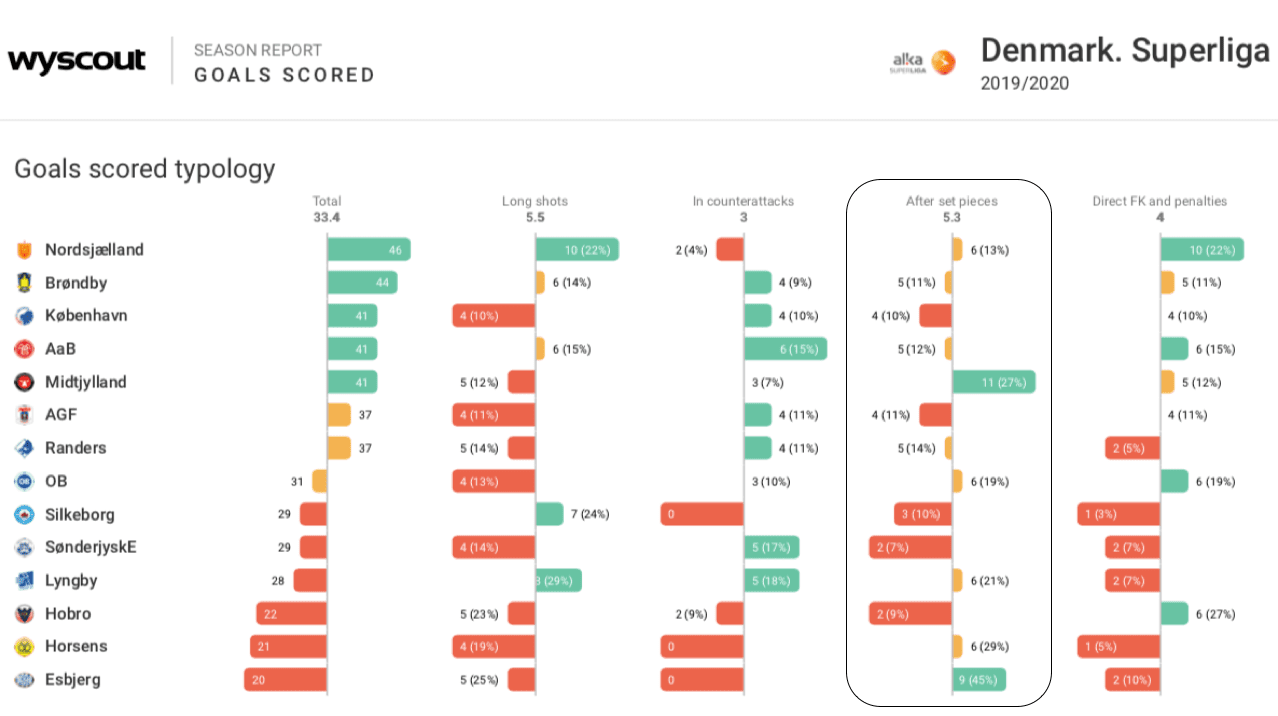
When looking at the set-piece data in the image below, we see that Esbjerg, OB and Lyngby and been very efficient as they are below the league’s average for set-pieces taken (111.5) but have scored more than the league’s average for goals from set-pieces (5.28). Both Midtjylland (11) and Nordsjælland (6) have also been effective as they are above the league average for goals from set-pieces.
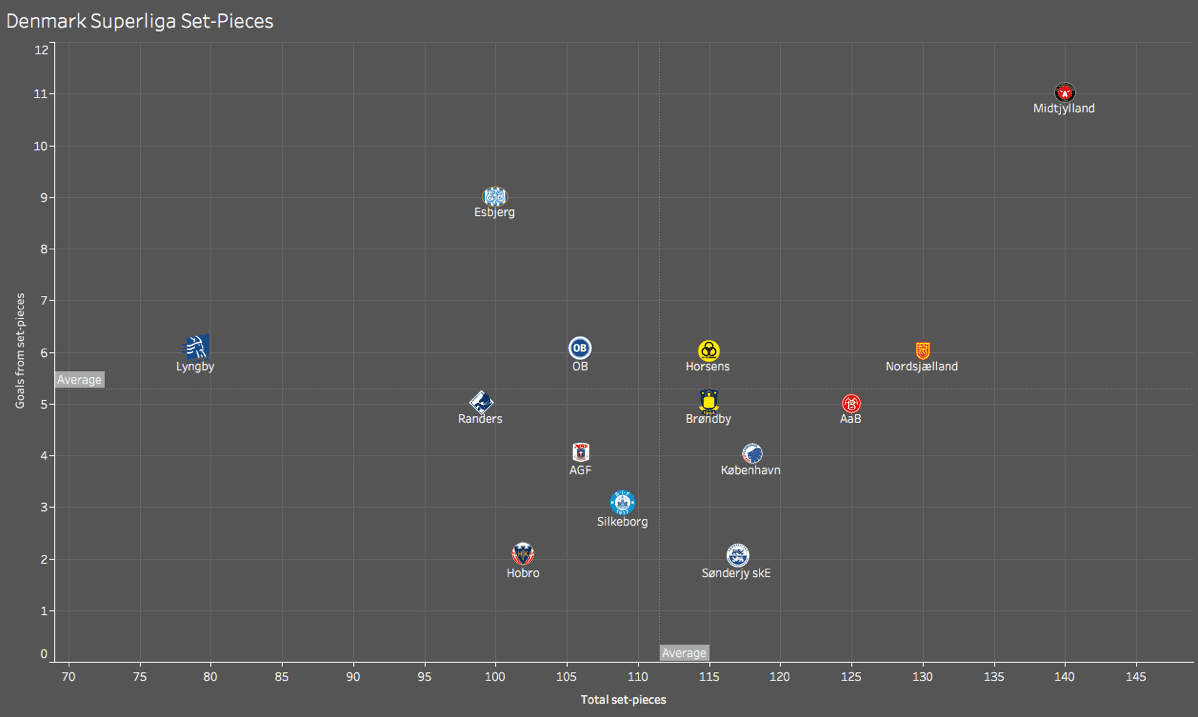
It will be interesting to note where the ball is delivered in the box, to discover any trends and what the successful teams are doing differently compared to the unsuccessful sides. The next image shows deliveries to the far post area, where SønderjyskE (38), Midtjylland (37), Lyngby (33) and Esbjerg (33) have had more than the league’s average of 23.71 deliveries to this area.
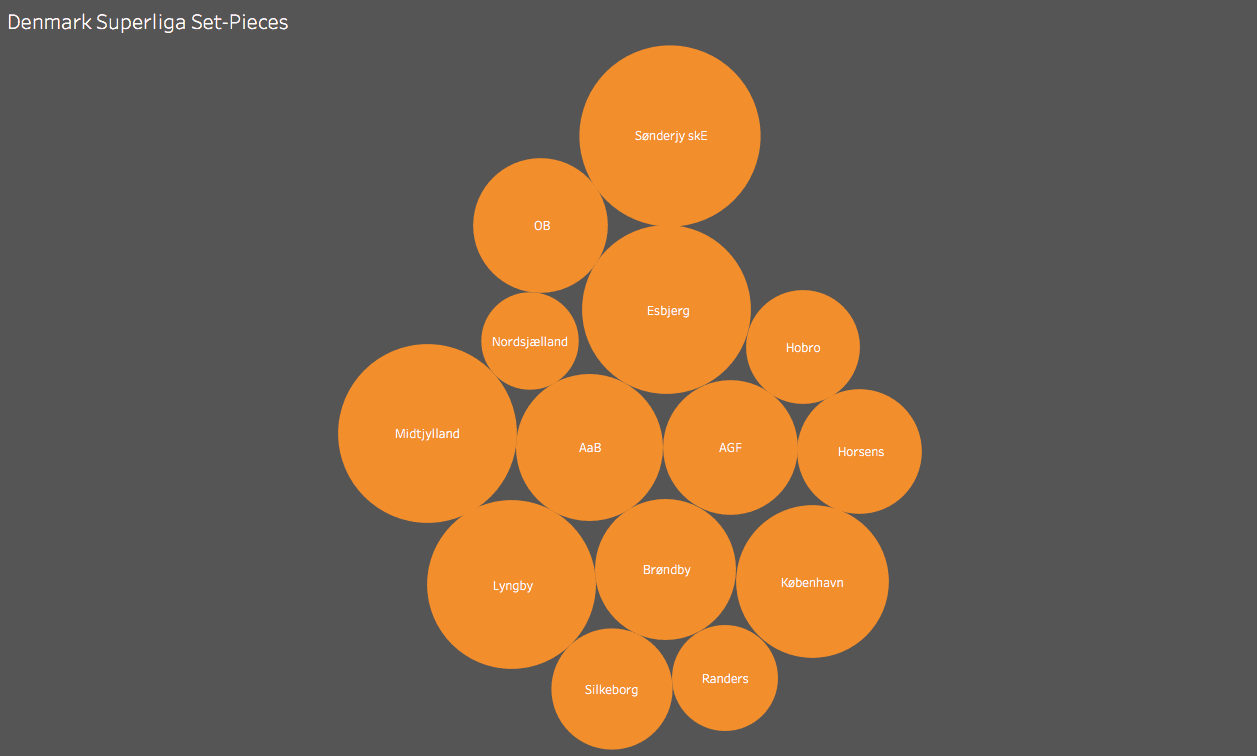
It gets interesting in the other areas as well, as we see varied approaches from teams. In the image below, the first team that stands out is Midtjylland’s high number of balls to the penalty area (23, indicated by the dark red dot) compared to the rest of the league. This is a clear and significant differentiator, as the image shows, with no other team coming close to having sent so many balls into the penalty area.
The next noticeable trend is Nordsjælland’s (48) high number for short passes compared to the rest of the league. For near post deliveries, København (43) have the highest number of deliveries in the league. Finally, for balls delivered to the goalkeeper’s area, most of the teams had similar numbers, other than Randers (47) and AaB (46).
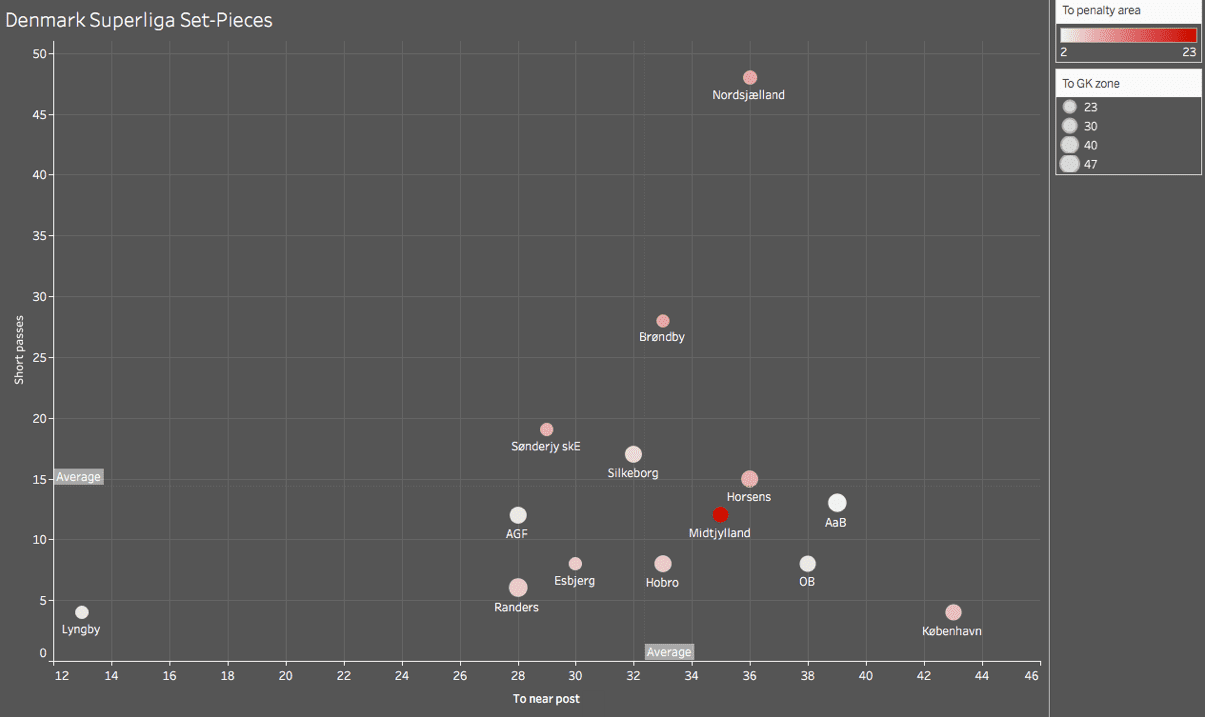
From the data, two teams have stood out and we will delve into their tactics using footage to see why they are so successful. The first team is Midtjylland for their significant emphasis on penalty area deliveries, as well as them ranking the highest for far post deliveries as well. Midtjylland were also the most effective in the league as they took a shot 36.4% of the time, which resulted in them also being the top scorers from set-pieces (11).
The other team is Nordsjælland who impressed with the high number of short set-pieces. The short set-pieces will be very interesting to analyse as they require extra movement to free up space. I will now use the footage to analyse the teams in further detail and give more context on their routines.
Midtjylland
First, we will look into Midtjylland’s clever corner routines, and then we will analyse their unique free-kicks. Midtjylland’s main corner taker is Evander, who has taken a total of 23 this season. He is right-footed, and thus sends in inswinging corners from the left and outswinging corners from the right, with the team showing a preference for right-footed takers, as seen in the next image.
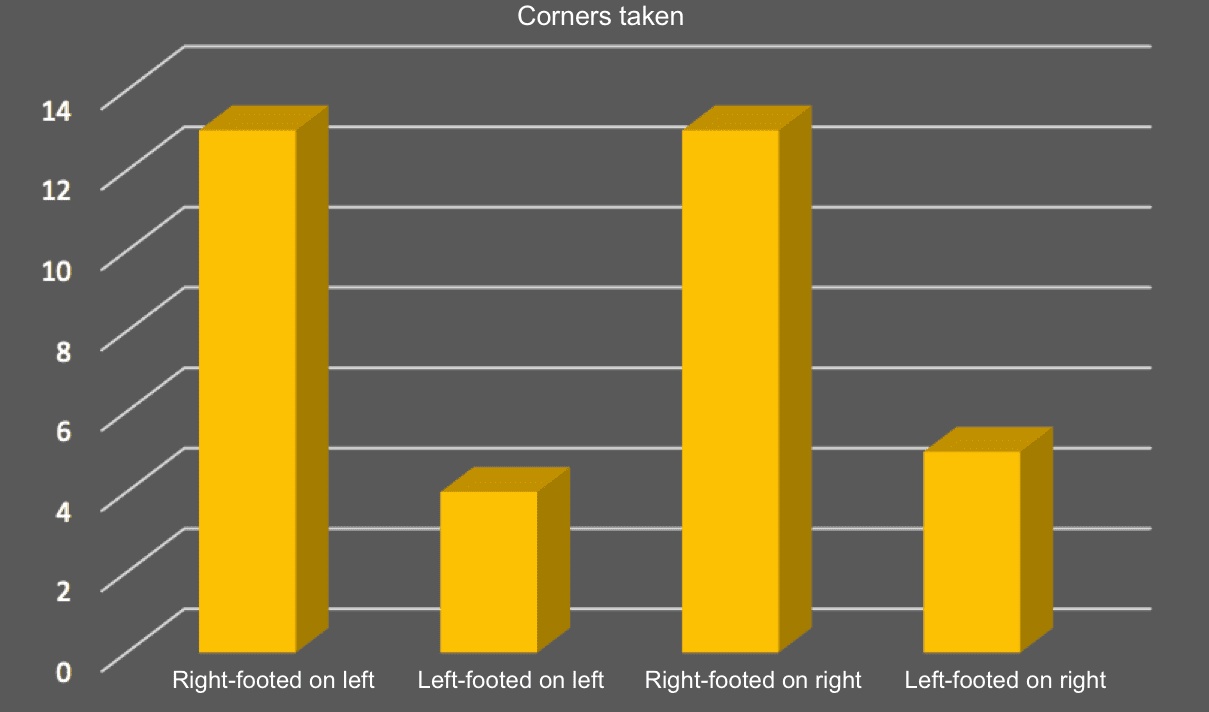
As we highlighted earlier, Midtjylland target the back post and the penalty area in dead-ball situations. They set up effectively by having players create space for others to attack. The team mainly uses the player on the edge of the box or the one furthest from the area, to be the one meeting the ball when the set-piece is delivered.
In the image below, we can see this being demonstrated. The goalkeeper is blocked by a Midtjylland player, who is stopping him from coming to collect the cross. The player at the back cuts around the big group of players into the unmarked space due to the opponent being preoccupied with that group of players clustered together.
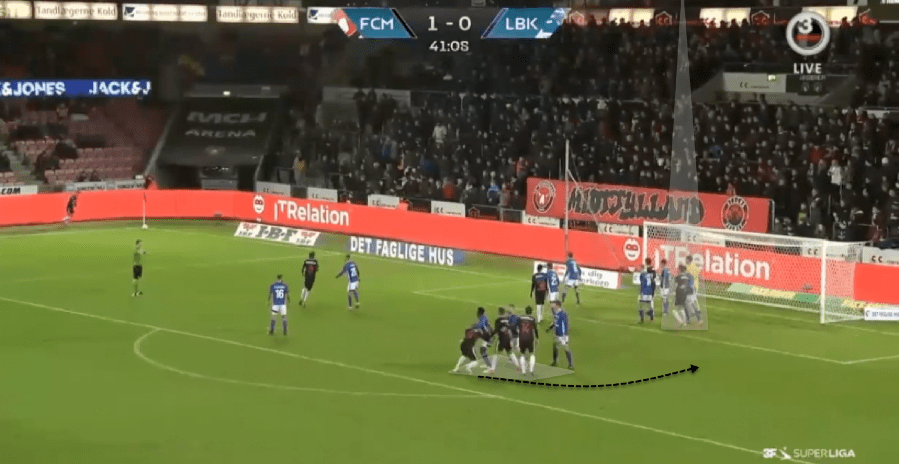
However, it is their brilliance of the players who create space for their teammates which has been one of the biggest reasons for Midtjylland’s success. In the image below, the opposition has opted for zonal marking on the six-yard box but this does not stop Midtjylland. To combat this, they use certain players as screens to block their opponents’ runs, and this results in freeing up space in behind. In the image below, we can see two Midtjylland players screening the play for a run to the back post which allows the runner to get a free look at goal.
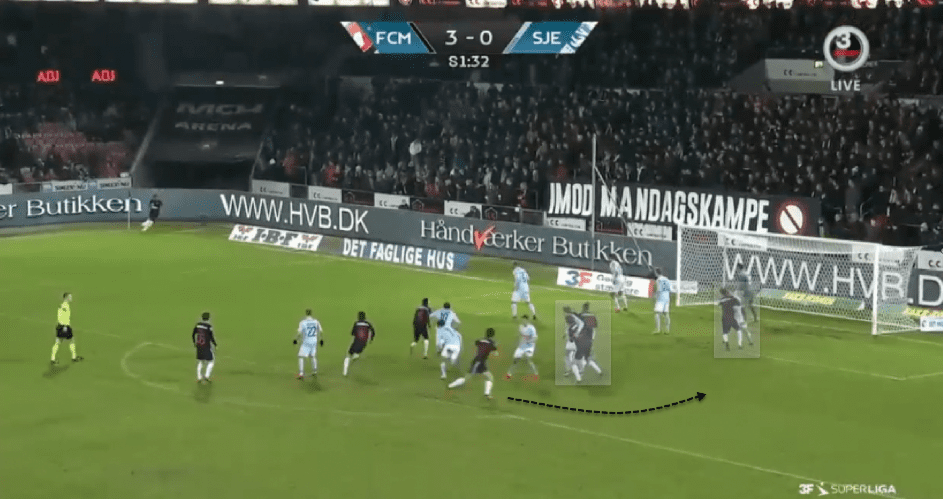
Mixing NBA and NFL plays into football might not be everyone’s first thought but Midtjylland have proven that there is a way to fit them in. This time in the image below, they look for the wide player (white line) to cut inside to create the space, and the central player (black line) to vacate the space left from his teammate’s movement. This is often used in basketball for the player on the wing to come inside and open up the shot for the central player arriving out wide.
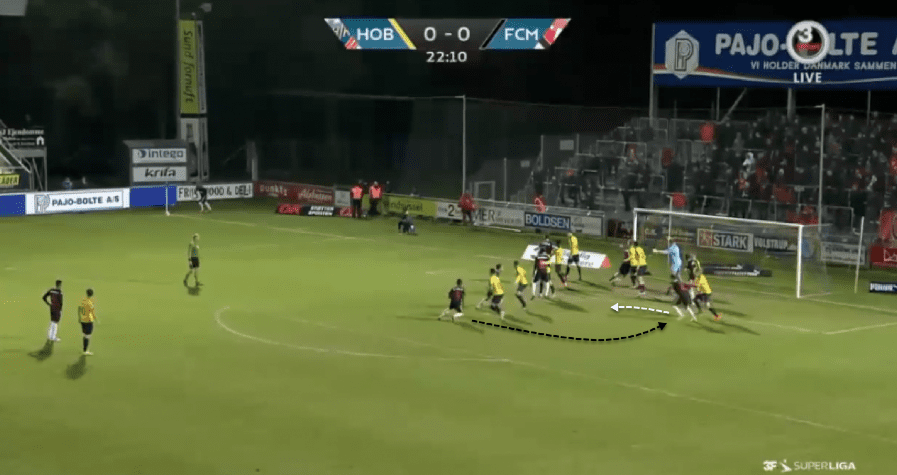
In the image below, the play continues as we can see the player move into space, but more importantly, there is a screen to prevent the opponent from moving out and interfering with play. This is a classic play that is used in basketball when one player leaves the space and the other gets a screen set so his teammate is left open.
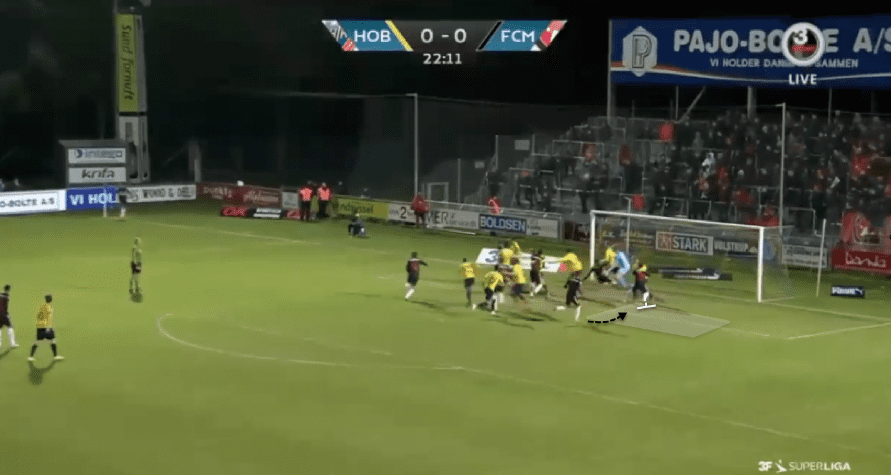
The corners are brilliantly drilled and combined with well-timed movements and effective screening to create their chances. Blocking runs are becoming a bigger part in set-pieces and Midtjylland are showing why it is a great way to create separation for their teammates.
Fancy free-kicks
Now we will move onto Midtjylland’s free-kicks. When they are setting up for a free-kick, they will have two players over the ball. One player will approach the ball and then retreat before hitting it. This indicates to the teammates to start their movement or second movements into space. Plus, it causes confusion for the opponents as they are unsure of which player is going to deliver the cross.
In the image below, the first player has triggered the runs by approaching the ball and the second player clips it over the top to the onrushing players. The signal allows their teammates to know which play is coming and leaves their opponents in the dark.

Out of frame in the image below, Midtjylland again used the trigger with two players over the free-kick. This shows how effective it is as it allows the attackers to make their runs beyond the defenders. We can see the two Midtjylland players ahead of the opponent’s defensive line as they react quicker than their opponents.
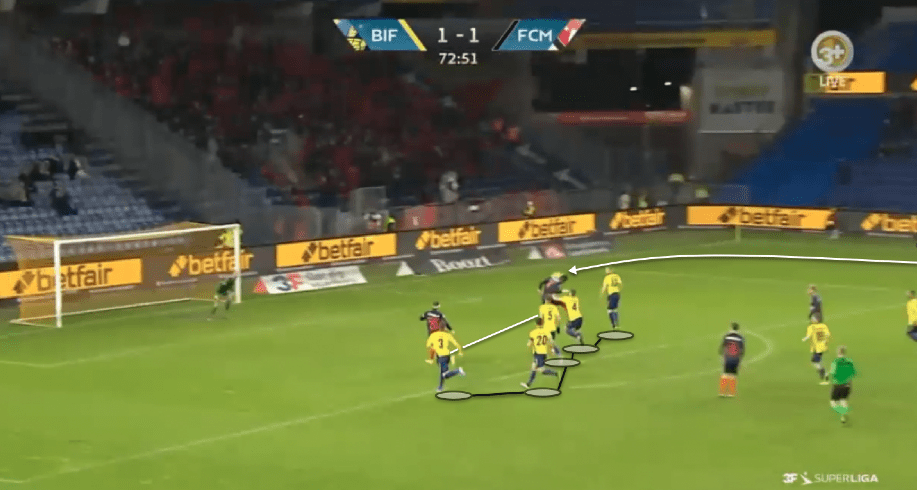
Midtjylland have mastered the long switch routine which allows a player to make an unmarked deep run into the area. In the image below, the first player triggers the run to start.
Then in the following image, the second player clips the ball over the top into space for the player to run onto. This resulted in a goal as the attacker had an uncontested pass due to an offside player moving across to block the last defender, while the two central players moved to the back post to receive the cutback.
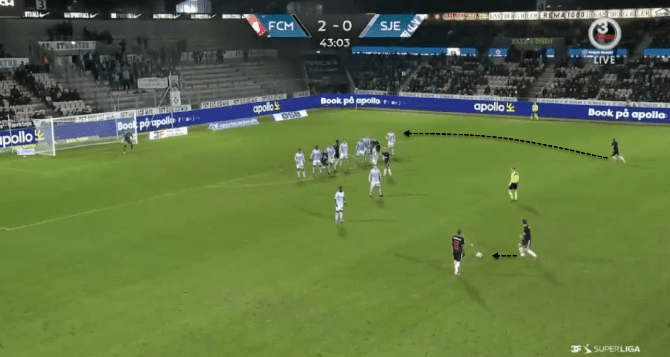
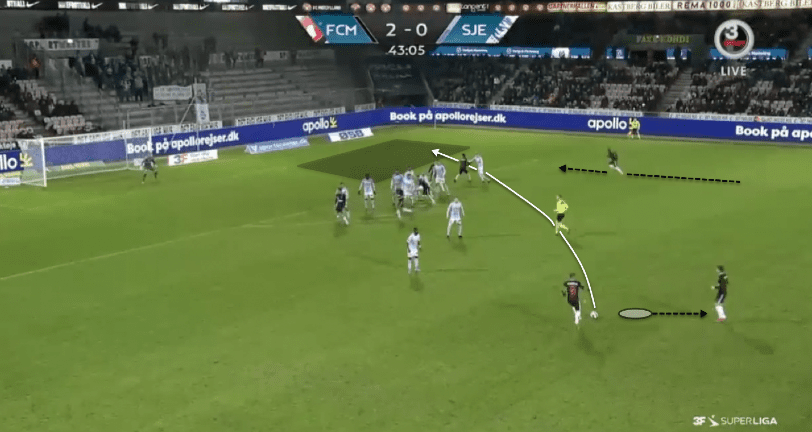
Midtjylland have come up with some distinctive tactics on their free-kicks. The trigger player has helped them disjoint defences and find gaps for players to exploit through deep runs, and this is just one example to show how they are definitely changing the game for set-pieces with unique routines and movements off the ball.
Nordsjælland
Unlike Midtjylland, Nordsjælland are much more creative with their corners rather than their free-kicks. Nevertheless, they are still implementing high-quality tactics in both. In the image below, we can see the first part of the play where there are four players stretching the opponents at the far post and overloading the near side. This allows space in the centre which opens shooting lanes for players to rotate into.
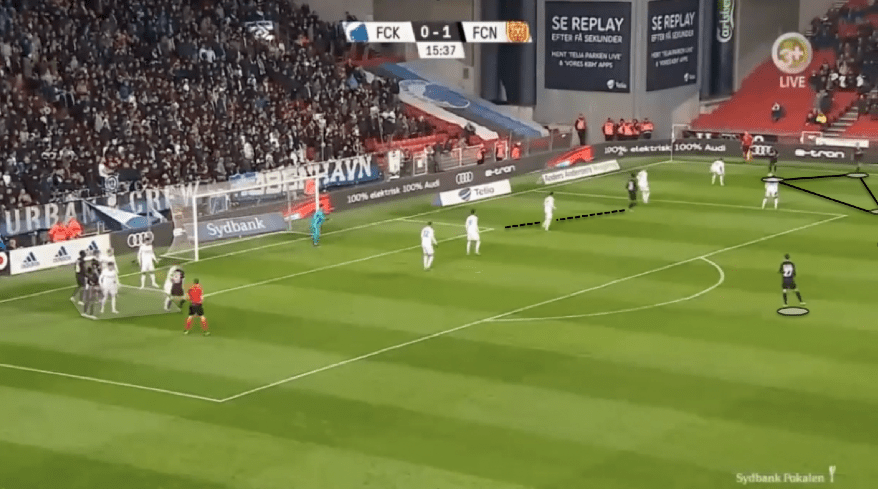
The play continues and they opt for their go-to short corner routine, whereby they retain possession by playing it backwards, and thus their opponents naturally move out from their deep position to the edge of the box. They mainly regroup centrally to cover the space in the defence, but this leaves Nordsjælland free to use the wide areas for overloads and getting players in behind into the highlighted area. As we can see in the image, there are two free players on the left and a 3v2 overload on the right-hand side.
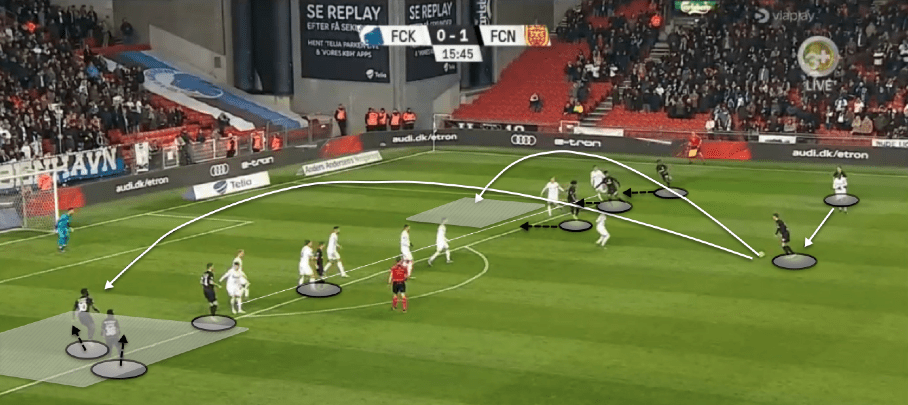
This time in the image below, Nordsjælland set up by loading the shooting lane. Additionally, they are still overloading the near side as they create a 4v3 with the rebounding player offering support.
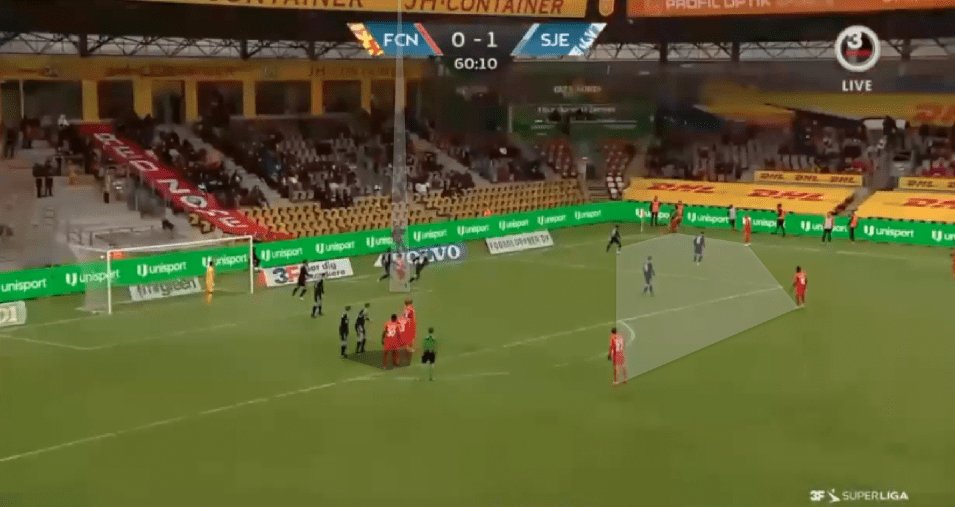
However, the player’s next movement in the penalty box serves to free up the shooting lane. In the image below, you can see Nordsjælland players splitting, with two going to the near post and the other two going to the far post, which frees up the shooting lane in the centre.
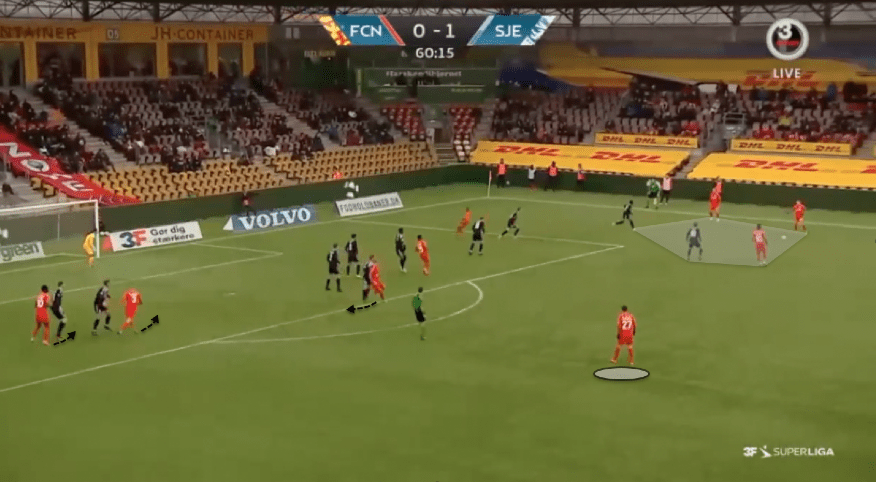
The team retains possession as it is a 3v2 so they can combine passes together. One player stays as a rebounder on the edge of the box but he is only there for support if it gets recycled back to him. As the space in the shooting lane opened up, the players in the box made a cut back in, as we can see one coming from the right-hand side and two drifting in from the left.

However, their free-kicks have used even cleverer routines to create space and get into ideal scoring positions. The key here is their use of the wide ball combined with smart movements.
In the image above, the runs are triggered by the player dummying the ball, a bit like Midtjylland do when they approach the ball and then retreat. This confuses the opponents and allows Nordsjælland to have the edge of moving first due to them reacting better by knowing what is coming. Centrally, two players are offside but they are looking to pounce onto the second ball, they are on the blind side of the opponents and also goal side, allowing them to get to the ball before the defenders. The crosser hits the black highlighted area, and in the meantime the central players ahead towards the white highlighted area waiting for the cutback.
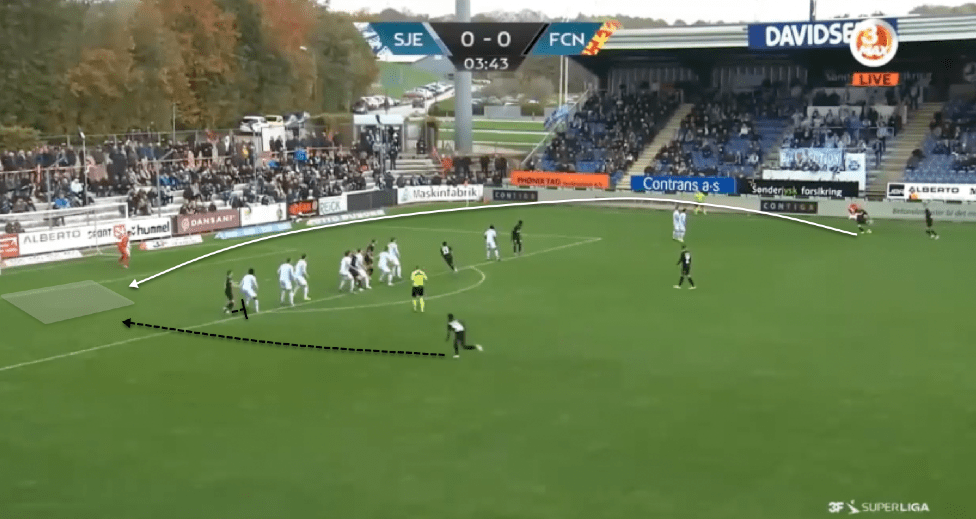
Earlier we saw Midtjylland include the use of screens, however, Nordsjælland are no strangers to it as well; they use them less but still involve them in some routines. In their free-kicks, they often go for the long switch where a player will run from deep. In the image above, the dummy over the ball triggers the deep player to run towards the far post, in conjunction with a screen on/blocking of the back post marker.
Conclusion
To conclude, set-pieces are becoming a bigger part of football as we see top teams like Liverpool and other Premier League sides focusing on them more. This piece highlighted the unique Denmark Superliga set-pieces and the emergence of NBA routines in their dead ball situations. Both Midtjylland and Nordsjælland are leading the way but we have noticed slight variations between both teams, as Nordsjælland opt for the short routine with overloads and space creation to exploit areas, whereas, Midtjylland are mostly targeting the penalty area with the use of screens/blocking to free up teammates. These plays can be confusing at first but with time and organisation put in the training ground, they can be highly effective and help teams pick up crucial points in the season.

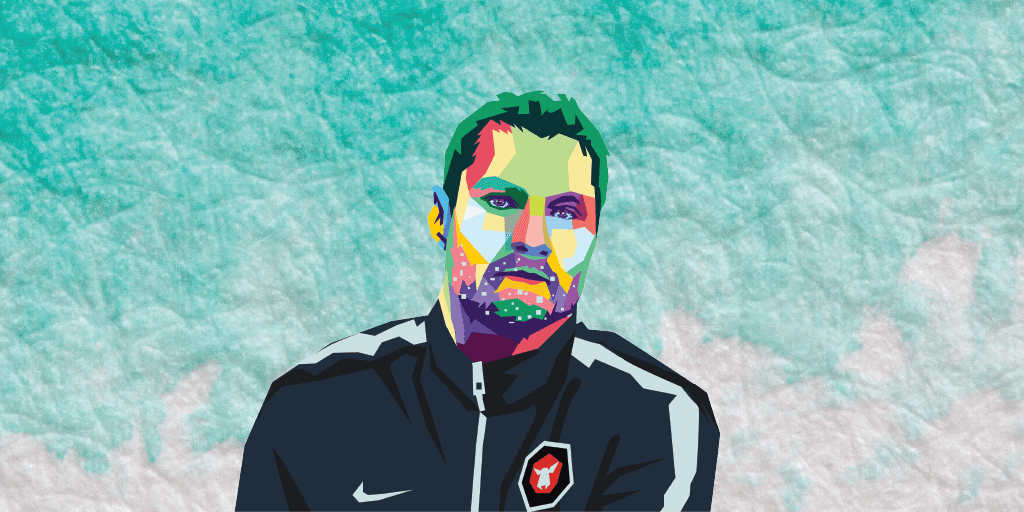



Comments